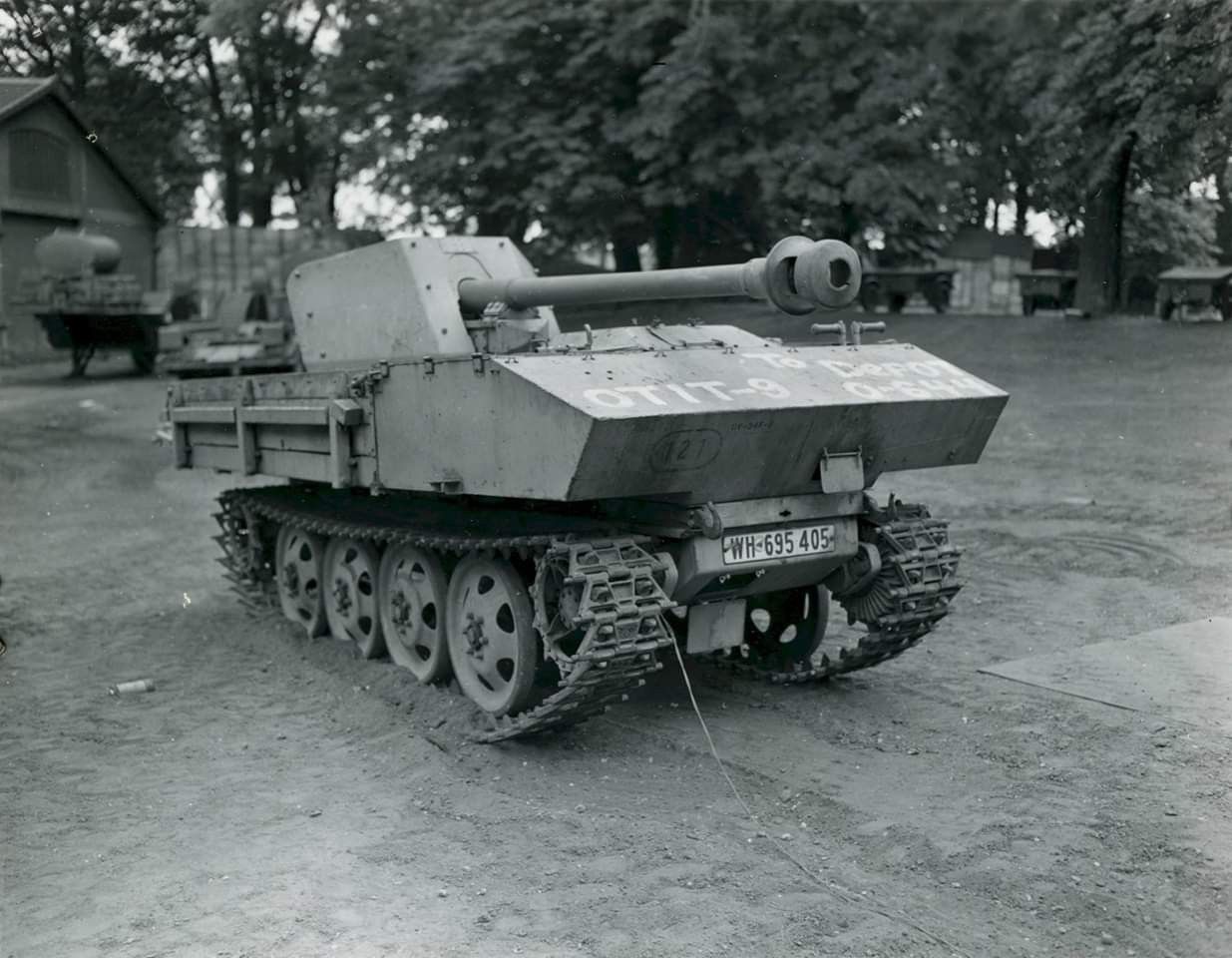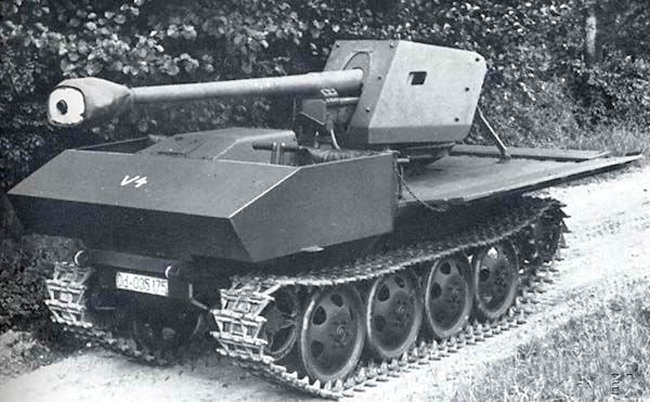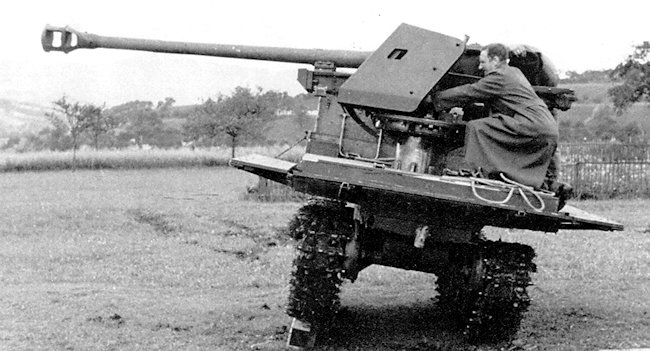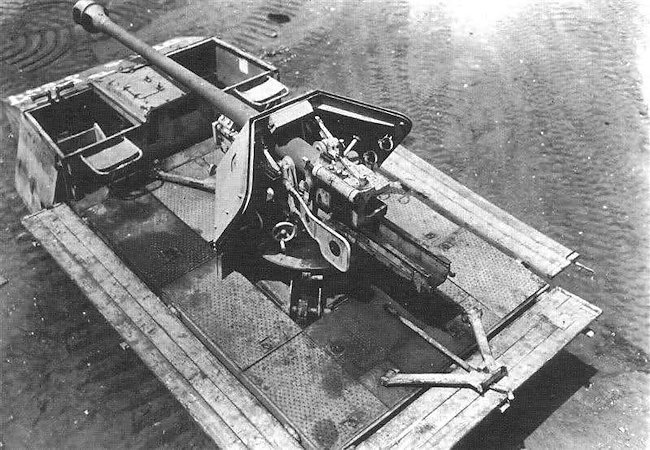
The PaK 40 auf RSO – A Tank Destroyer with an Overly Large Gun
The term “glass cannon” is often used to signify a vehicle with lots of firepower, but minimal armor. The PaK 40 auf RSO is one of the most extreme examples of this, with the powerful 7.5 cm PaK 40 anti-tank gun mounted on a very small tracked chassis originally designed to haul cargo.
The vehicle was based on the Raupenschlepper Ost chassis, a cargo vehicle better known as the RSO. This little thing was not much larger than a small truck, but was modified to carry a disproportionately large gun.
Once fitted, this little machine that weighed just 6 tons was capable of killing most tanks on the battlefield. In the end though, Germany would be shown why leaving a crew exposed to enemy fire was a bad idea.
Background
The 7.5 cm Pak 40 auf RSO comes from the same line of thinking that resulted in the German Panzerjäger vehicles, like the Marders and Nashorn.
These vehicles were a solution to quite a serious issue relating to the practicality of anti-tank weapons.
At the start of the war Germany had anti-tank (AT) battalions attached to Army divisions to deal with enemy armor. The problem was that these weapons were still being pulled around by half-tracks and wheeled vehicles, requiring them to be pulled into a position, disconnected from the tractor and then set up by the crew.
The PaK 40 anti-tank gun (center). On the right is a the 37 mm PaK 35/36, and behind the PaK 40 is the 50 mm PaK 38.
To make matters worse, newer guns were becoming increasingly heavy and made this even harder. A truck pulling a 1.5 ton PaK 40 was vulnerable to enemy fire and could easily become stuck in rough terrain. Even once it was disconnected, the crew struggled to precisely position the gun themselves due to its weight.
The Germans quickly began looking into eliminating these issues by simply mounting the gun on a tracked chassis (usually one from a smaller, older tank). This way, the vehicle could move through rough terrain, the gun could fire almost instantly, and repositioning was faster and easier.
Read More The Kettenkrad – is it a Motorcycle or a Tank?
In 1943 plans were made to mount the 7.5 cm PaK 40 anti-tank gun on the chassis of a small cargo vehicle known as the RSO (RSO stood for Raupenschlepper Ost, meaning Eastern Tracked Tractor). This followed the previous idea of making a stationary anti-tank weapons mobile.
The RSO itself is an interesting little vehicle. It was designed early in the war to help with the general movement of equipment and supplies through the thick mud encountered on the Eastern Front. These conditions were tough even for half-tracks, but the RSO was fully tracked.
The RSO tractor. Later versions had a square, canvas-topped cab. Image by Rainerhaufe CC BY-SA 4.0.
It did away with the complex, overlapped suspension systems found on other German vehicles, and instead ran on four simple road wheels and dry pin tracks. In fact, everything about the RSO was simple, verging on crude. An 85 hp V8 petrol engine was located at the front, and above it was a basic cab.
Its simplicity proved extremely valuable on the Eastern Front, surviving the brutal conditions much better than similar, more complex vehicles. It was also excellent over rough ground, and in much the same way as the Kettenkrad, would be used in a huge variety of roles thanks to its exceptional practicality.
Designed by Steyr, the RSO entered service in 1942 and remained in use until the end of the war, by which point nearly 30,000 had been built.
In early 1943 work began on developing a self-propelled gun on the basis of the RSO, armed with the PaK 40. This decision was logical; the RSO was reliable, easy to make and performed great. Plus, it was already being used to tow the PaK 40, so why not combine the two into a single platform?
Development
Wa Pruef 4, the German office in charge of artillery developments, began working with Steyr to develop this vehicle. Rheinmetall-Borsig also participated in the project in areas relating to the gun.
To begin with the project saw an entire unmodified PaK 40, with its split trail legs, simply placed in the cargo bed of an RSO. Eventually a proper base was developed for the gun, so it could be securely mounted on the RSO.
Read More Germany’s Nashorn Tank Destroyer with an 88 mm
The cab was redesigned into a low profile wedge shape that gave the gun clearance over the front of the vehicle.
 The 7.5 cm PaK 40 auf RSO. The front wedged-shaped section house the driver and engine.
The 7.5 cm PaK 40 auf RSO. The front wedged-shaped section house the driver and engine.
The gun base was designed in such a way that the upper portion of the PaK 40, including the gun shield, could be attached, requiring no modifications to the gun itself. If needed, the gun could be dismounted and placed back on the basic PaK 40 mount.
It was envisaged that if the RSO was damaged or became stuck, the PaK 40 could be removed and towed away by another vehicle, reducing material losses.
The base could traverse 360 degrees too, giving the gun all-around fire capability.
The two systems combined together had better mobility and practicality than when they were separate; the RSO would no longer be pulling a gun carriage through mud or difficult terrain, and the crew could fire the gun much faster once coming to a stop. Similarly, it was as simple as securing the gun and driving away once firing was complete, rather than having to pack up the gun and ammunition then hook it up to the tractor. A rear view of the PaK 40 auf RSO. Note the pedestal mount that the gun attached to.
A rear view of the PaK 40 auf RSO. Note the pedestal mount that the gun attached to.
But this system wasn’t just more practical, it eased the stress on manufacturing and logistical systems. The total weight of an RSO towing a PaK 40 was less than an RSO carrying a PaK 40, so fuel and wear would be reduced. In addition, fewer raw materials were required (no longer needing the full PaK 40 carriage), and less crew were needed (four versus eight).
Tests were carried out in 1943, with one of the early concerns being the vehicle’s stability when firing the gun sideways, as it was rather top-heavy. This proved to not be an issue, and the vehicle, designated the 7.5 cm PaK 40 auf RSO, was demonstrated to Hitler before the end of 1943.
He was very impressed with the vehicle, which, in theory, provided tank-killing power on a small, self-propelled platform weighing less than 6 tons. To further examine the concept in live combat, a batch of 50 test vehicles were ordered in September 1943.
The 7.5 cm PaK 40 auf RSO
The PaK 40 auf RSO retained the simplicity of its RSO basis – quite literally consisting of a set of tracks, an engine, and a high-velocity anti-tank gun.
The running gear and engine remained the same as on the RSO, with four simple road wheels per side and an 85 hp engine in the front. It also inherited the RSO’s excellent 55 cm ground clearance, which was largely why its off-road performance was so good.
Read More M-1978 Koksan – North Korea’s 170 mm SPG
But the PaK 40 auf RSO had an entirely new front end that left the driver completely exposed – not that the cab of the standard vehicle provided any protection against incoming fire. It was wedge-shaped and armored to a maximum of 10 mm.
 The PaK 40 auf RSO had the same great ground clearance of the standard RSO. But unfortunately this made it tall and unbalanced.
The PaK 40 auf RSO had the same great ground clearance of the standard RSO. But unfortunately this made it tall and unbalanced.
Directly behind this was a open platform that contained the gun, its mount and space for the crew to work. On the standard RSO, this was simply the cargo bed.
The platform floor served as ammunition storage for the PaK 40, with the rounds accessed by lifting panels. This rear area was surrounded by wooden sideboards, similar to a normal cargo truck, but when in action they could be dropped down to increase the crew’s working space.
In the center of the fighting platform was the 7.5 cm PaK 40 anti-tank gun. This was a great anti-tank weapon that could deal with most Allied tanks fielded throughout the war. With its most powerful ammunition it was capable of punching through 100 mm of steel from 1,000 meters away.
 A top view from the rear of the PaK 40 auf RSO showing its gun platform. As seen here, the sideboard have been dropped to increase the platform’s size. Note the panels in the floor that covered the ammunition.
A top view from the rear of the PaK 40 auf RSO showing its gun platform. As seen here, the sideboard have been dropped to increase the platform’s size. Note the panels in the floor that covered the ammunition.
Triangular gun locks were located at the front and rear of the bed to secure the gun in place while the vehicle was moving.
The crew were only protected by the standard PaK 40 gun shield, which consisted of a 4 mm thick plate, a 25 mm air gap, then another 4 mm plate. This left them extremely vulnerable to enemy fire, even more so than on a towed PaK 40 because it was higher up.
To help provide some protection from the elements, the PaK 40 auf RSO was fitted with a canvas screen that could be erected over the vehicle.
 This surviving example in the Panzermuseum Munster is displayed with its canvas cover erected. Image by Triple-green CC BY-SA 2.0
This surviving example in the Panzermuseum Munster is displayed with its canvas cover erected. Image by Triple-green CC BY-SA 2.0
Read More Object 327 – This Soviet SPG Carried its Weapon on The Outside
One of the major drawbacks of the vehicle however was its top speed. The RSO was already a rather slow vehicle (with a top speed of 19 mph on road), but the added weight of the PaK 40 hampered this further. As a result, it had a top road speed of just 11 mph, which significantly impacted its usefulness as a mobile tank destroyer.
Fate
As mentioned, an order for 50 PaK 40 auf RSOs was placed in September 1943, as on paper it looked like a very promising tank destroyer. In fact, Hitler initially requested a production run of 400 examples.
However in early 1944 reports started coming back from the frontlines that the vehicles were actually rather ineffective; suffering from low speed, loud engines and some reliability troubles.
The most alarming problem though was the vulnerability of the crew. Positioned high up, with virtually no armor protection, they were terrifyingly exposed to the weather, enemy fire and shrapnel.
Of course, the PaK 40’s performance was already known, and when it hit it hit hard, but its use on this vehicle was not the match made in heaven you’d expect.
The completely open top and sides left the crew extremely vulnerable, making it an unpopular vehicle.
With these damning reports, Hitler ordered that the project be canceled in June 1944.
Still, around 60 were built (this can vary between 60 and 90 depending on the source), and these were issued to units on the front lines.
Despite being built for use by the infantry, they were mostly given to armored divisions in an attempt to replace their heavily depleted forces.
Opinions on the 7.5 cm PaK 40 auf RSO didn’t change over the course of their service, and overall were unpopular among their crews.
Today there is only a few complete 7.5 cm PaK 40 auf RSOs left.
News
The Hanging Temple: China’s 1,500-Year-Old Cliffside Marvel of Faith and Engineering
The Hanging Temple: China’s 1,500-Year-Old Cliffside Marvel of Faith and Engineering Perched precariously on the cliffs of Mount Heng in Shanxi Province, China, the Hanging Temple, also known as Xuankong Temple, Hengshan Hanging Temple, or Hanging Monastery, is an architectural…
The Willendorf Venus: A 30,000-Year-Old Masterpiece Reveals Astonishing Secrets
The Willendorf Venus: A 30,000-Year-Old Masterpiece Reveals Astonishing Secrets The “Willendorf Venus” stands as one of the most revered archaeological treasures from the Upper Paleolithic era. Discovered in 1908 by scientist Johann Veran near Willendorf, Austria, this small yet profound…
Unveiling the Maya: Hallucinogens and Rituals Beneath the Yucatán Ball Courts
Unveiling the Maya: Hallucinogens and Rituals Beneath the Yucatán Ball Courts New archaeological research has uncovered intriguing insights into the ritual practices of the ancient Maya civilization. The focus of this study is a ceremonial offering found beneath the sediment…
Uncovering the Oldest Agricultural Machine: The Threshing Sledge’s Neolithic Origins
Uncovering the Oldest Agricultural Machine: The Threshing Sledge’s Neolithic Origins The history of agricultural innovation is a fascinating journey that spans thousands of years, and one of the earliest known agricultural machines is the threshing sledge. Recently, a groundbreaking study…
Nara’s Ancient Sword: A 1,600-Year-Old Protector Against Evil Spirits
Nara’s Ancient Sword: A 1,600-Year-Old Protector Against Evil Spirits In a remarkable discovery that has captured the attention of archaeologists and historians alike, a 7.5-foot-long iron sword was unearthed from a 1,600-year-old burial mound in Nara, Japan. This oversized weapon,…
The Inflatable Plane, Dropped Behind the Lines for Downed Pilots
Experimental The Inflatable Plane, Dropped Behind the Lines for Downed Pilots The Inflatoplane from Goodyear was an unconventional aircraft developed by the Goodyear Aircraft Company, a branch of the renowned Goodyear Tire and Rubber Company, also famed for the Goodyear…
End of content
No more pages to load











